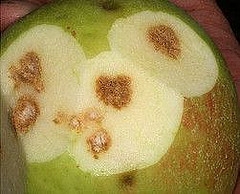Penn State scientists part of new stink bug research project
live.psu.edu/story/56032#nw69
October 27, 2011

Stink-bug damage such as this cost the mid-Atlantic apple industry an estimated $37 million in 2010. (Credit: Penn State Department of Entomology)
UNIVERSITY PARK, Pa. — Researchers in Penn State’s College of Agricultural Sciences are part of a new, multi-state project to study the brown marmorated stink bug.
The research is funded by a recently announced $5.7 million grant from the U.S. Department of Agriculture’s National Institute of Food and Agriculture through its Specialty Crops Research Initiative.
The three-year project is aimed at developing economically and environmentally sustainable pest-management practices for the brown marmorated stink bug, which has caused millions of dollars worth of crop damage and become a major homeowner nuisance since it first was found in the United States, near Allentown, in the late 1990s.
Penn State will receive nearly $900,000 of the grant to study stink bug biology and behavior, develop monitoring and management tools and practices, and provide extension education programs to disseminate new knowledge to crop producers.
“It’s too early to put a dollar value on crop damage this year, but the apple industry alone estimated losses of about $37 million as the result of stink bug infestations in the mid-Atlantic region in 2010,” said Greg Krawczyk, extension tree-fruit entomologist at Penn State’s Fruit Research and Extension Center in Biglerville.
Krawczyk, who leads the Penn State portion of the project, noted that crop damage this year appears to be lower than last year, though it varies from region to region. “Growers who experienced big losses last year managed this pest better during this season, but some individual growers still suffered losses of up to 60 percent,” he said.
Because the brown marmorated stink bug is native to Asia, it has few natural enemies in North America, allowing populations to grow largely unchecked. The pest is known to feed on as many as 300 host plants and migrates readily, further complicating control.
Krawczyk said one of the goals of the research is to develop control tactics that rely on the principles of IPM, or integrated pest management. IPM utilizes a variety of methods — including biological controls, pheromones for mating disruption and other techniques — that help minimize pesticide use.
He explained that some broad-spectrum pesticides that are effective against stink bugs also kill the beneficial insects tree-fruit growers rely on as part of IPM programs. “That upsets the balance in the orchard ecosystem — allowing other pests to become more of a problem — and could reverse much of the progress we’ve made in IPM, which has helped Pennsylvania growers to reduce pesticide use by as much as 75 percent in recent decades.”
Penn State scientists will study stink bugs as they relate to the production of tree fruits, vegetables and grapes. Researchers will explore biological control options, stink-bug chemical ecology (chemically mediated interactions among plants and insects), and monitoring strategies. The project also will assess the pest’s economic impact and the economic feasibility of new management methods.
Krawczyk said although the research will focus mostly on specialty crops and will not directly address infestations in homes or in major agronomic crops such as corn and soybean, knowledge gained should aid in the development of recommendations that could be useful for habitat-scale management.
Other Penn State personnel taking part in the project include David Biddinger, senior research associate in entomology at the Fruit Research and Extension Center; Gary Felton, professor and head of entomology; Shelby Fleischer, professor of entomology; Jayson Harper, professor of agricultural economics; Steven Jacobs, senior extension associate in entomology; Michael Saunders, professor of entomology; and John Tooker, assistant professor of entomology.
The project is led by USDA’s Agricultural Research Service, along with a core group of land-grant universities: Penn State, Rutgers, Virginia Tech, and the universities of Maryland and Delaware. Also participating are researchers from Cornell, Oregon State University, North Carolina State University, Washington State University and the Northeast IPM Center.
More information about the brown marmorated stink bug is available online at http://ento.psu.edu/extension/factsheets/brown-marmorated-stink-bug.

Wonderful beat ! I would like to apprentice while you amend your site, how can i subscribe for a weblog web site?
The account helped me a applicable deal.
I were a little bit familiar of this your broadcast provided shiny clear concept
You ought to be a part of a contest for one
of the best sites on the web. I will recommend
this blog!